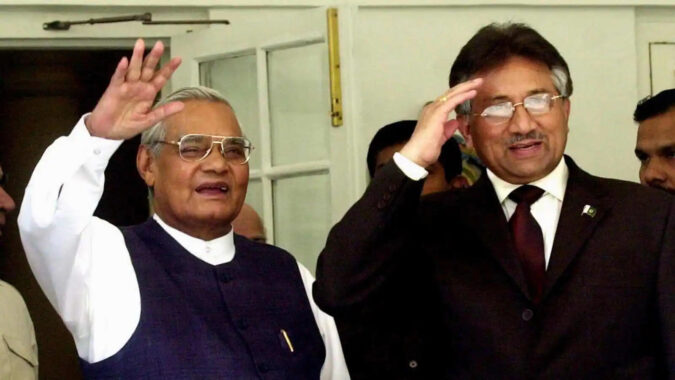Musharraf’s complicated ties with India:
- Musharraf was born in August 1943 to a middle-class family of Urdu-speaking Mohajir (immigrant) parents in Old Delhi’s Daryaganj. The ‘Neharwali Haveli’ was bought by Musharraf’s grandfather Qazi Mohtashimuddin following his retirement as the commissioner of Punjab. The property is now mostly in ruins.
- His family migrated to Pakistan after Partition in 1947.
- He fought in the Indo-Pakistan War of 1965 as a second lieutenant, and also participated in the Indo-Pakistan War of 1971 as a Company Commander in the Commando Battalion.
- After his failed misadventure in Kargil in 1998, Musharraf deposed Nawaz Sharif in a bloodless coup and ruled Pakistan from 1999 to 2008 in various positions – first as the chief executive of Pakistan and later as the President.
- Despite breakdown of relations with India several times, Musharraf was involved in several diplomatic efforts, peace talks, and negotiations with New Delhi, including the Agra Summit, the Lahore Declaration, the Joint Anti-Terrorism Mechanism, and numerous discussions regarding Kashmir.
- After the January 2001 Gujarat earthquake, Musharraf expressed his sympathies to then PM Atal Behari Vajpayee and sent a plane load of relief supplies to India.
- In July 2001, Musharraf and PM Vajpayee met for a two-day summit in Agra. However, the talks ended in failure.
- After the December 2001 attack on Parliament, ties between India and Pakistan nearly snapped as the neighbours amassed their militaries along the border. The standoff only ended in October 2002, a few months after Musharraf pledged that Islamabad would combat extremism on its own soil.
- In January 2004, Vajpayee and Musharraf held direct talks at the 12th SAARC summit in Islamabad, and the two countries’ foreign secretaries met later in the year. This marked the beginning of the Composite Dialogue Process, in which bilateral meetings are held between officials at various levels of government.
- In September 2006, Musharraf and PM Manmohan Singh agree to set up an India-Pakistan institutional anti-terrorism mechanism.
- Musharraf visited India thrice. He made his first visit to the country for the failed Agra summit in 2001. He also went to India in 2005 and 2009 to watch an India-Pakistan ODI cricket match and to attend a media event.
Musharraf resigned as president in August 2008 after ruling coalition officials threatened to have him impeached for imposing emergency rule and firing judges.
Afterward, he lived abroad in Dubai and London, attempting a political comeback in 2012. But Pakistan instead arrested the former general and put him under house arrest. He faced treason allegations over the Supreme Court debacle and other charges stemming from the Red Mosque raid and Benazir Bhutto’s assassination.
The image of Musharraf being treated as a criminal suspect shocked Pakistan, where military generals long have been considered above the law. Pakistan allowed him to leave the country on bail to Dubai in 2016 for medical treatment and he remained there after facing a later-overturned death sentence.
(With inputs from agencies)
